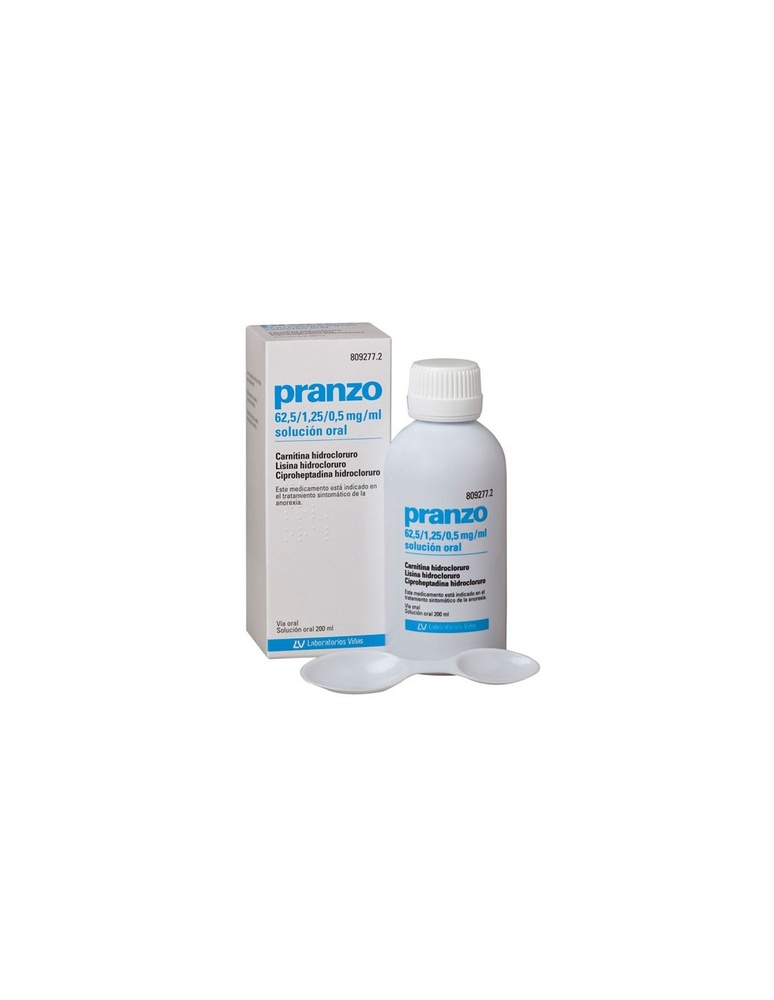

ПРАНЗО 62,5 / 1,25 / 0,5 мг/мл ОРАЛЬНИЙ РОЗЧИН

Запитайте лікаря про рецепт на ПРАНЗО 62,5 / 1,25 / 0,5 мг/мл ОРАЛЬНИЙ РОЗЧИН

Інструкція із застосування ПРАНЗО 62,5 / 1,25 / 0,5 мг/мл ОРАЛЬНИЙ РОЗЧИН
Введення
Опис: інформація для користувача
Пранзо 62,5/1,25/0,5 мг/мл
оральна суспензія
Гідрохлорид карнітину
Гідрохлорид лізину
Гідрохлорид ципрогептадіну
Прочитайте уважно весь опис перед тим, як почнете приймати цей лікарський засіб, оскільки він містить важливу інформацію для вас.
Слідуйте точно інструкціям щодо застосування лікарського засобу, наведеним у цьому описі або вказаним вашим лікарем чи фармацевтом.
- Збережіть цей опис, оскільки вам може знадобитися знову його прочитати.
- Якщо вам потрібна порада або додаткова інформація, проконсультуйтеся з фармацевтом.
- Якщо ви відчуваєте побічні ефекти, проконсультуйтеся з лікарем або фармацевтом, навіть якщо це побічні ефекти, які не наведені в цьому описі. Див. розділ 4.
Вам слід проконсультуватися з лікарем, якщо ваші симптоми погіршуються або не покращуються після 30 днів.
Зміст опису
- Що таке Пранзо і для чого він використовується
- Що вам потрібно знати перед тим, як почати приймати Пранзо
- Як приймати Пранзо
- Можливі побічні ефекти
- Збереження Пранзо
- Зміст упаковки та додаткова інформація
1. Що таке Пранзо і для чого він використовується
Пранзо - це лікарський засіб, який стимулює апетит, і він призначений для симптоматичного лікування анорексії.
2. Що вам потрібно знати перед тим, як почати приймати Пранзо
Не приймайте Пранзо
- Якщо ви алергічні на активні речовини або на будь-які інші компоненти цього лікарського засобу (наведені в розділі 6).
- У разі астматичної кризи.
- У разі порфірії (спадкового захворювання гемоглобіну крові).
- У разі вагітності або під час лактації.
- У дітей молодших 2 років.
Попередження та обережність
Проконсультуйтеся з лікарем або фармацевтом перед тим, як почати приймати Пранзо.
- Якщо у вас є історія бронхіальної астми, гіпертиреозу, серцево-судинних захворювань, гіпертонії та підвищеного внутрішньоочного тиску.
Хороший смак Пранзо може спонукати дітей до надмірного прийому лікарського засобу, тому його слід тримати поза їхньою доступністю.
Використання у дітей:
Не призначайте дітям молодшим 2 років.
Інші лікарські засоби та Пранзо
Повідомте лікаря або фармацевта, якщо ви приймаєте або нещодавно приймали інші лікарські засоби.
Не рекомендується приймати його разом з барбітуратами, бензодіазепінами та іншими депресорами центральної нервової системи, антидепресантами, інгібіторами зворотного захоплення серотоніну, такими як флуоксетин, алкалізуючими засобами, симпатикоміметиками, антикоагулянтами, естрогенами, прогестероном, дифенілгідантоїном, грізеофульвіном та інгібіторами моноамінооксидази.
Прийом Пранзо з їжею, напоями та алкоголем
Не рекомендується приймати цей лікарський засіб разом з алкогольними напоями.
Пранзо слід приймати до їжі.
Вагітність, лактація та фертильність
Якщо ви вагітні або перебуваєте у період лактації, вважаєте, що можете бути вагітною або плануєте вагітність, проконсультуйтеся з лікарем або фармацевтом перед тим, як приймати цей лікарський засіб.
Слід уникати прийому цього лікарського засобу під час вагітності та лактації.
Водіння транспортних засобів та використання машин:
Не рекомендується водіння транспортних засобів чи використання небезпечних машин (може знижувати здатність до водіння та рефлексів).
Пранзо містить сукрозу, етанол, пара-гідроксібензоат пропілу, натрій (Е-217), амарант (Е-123) та натрій.
Цей лікарський засіб містить сукрозу. Якщо ваш лікар сказав вам, що ви маєте непереносимість певних цукрів, проконсультуйтеся з ним перед тим, як приймати цей лікарський засіб.
Пацієнти з цукровим діабетом повинні знати, що цей лікарський засіб містить 0,6 г сукрози на дозу 2 мл, або 1,2 г сукрози на дозу 4 мл.
Може спричинити каріес.
Цей лікарський засіб містить 97,8 мг етанолу (алкоголю) на дозу 2 мл або 195,7 мг етанолу (алкоголю) на дозу 4 мл, що відповідає 4,89%. Кількість 2 мл цього лікарського засобу еквівалентна менш ніж 2,5 мл пива або 1 мл вина. Кількість 4 мл цього лікарського засобу еквівалентна 5 мл пива або 2 мл вина.
Малоймовірно, що кількість алкоголю в цьому лікарському засобі матиме будь-який помітний ефект на дорослих або підлітків. Він може мати деякий ефект на маленьких дітей, наприклад сонливість.
Кількість алкоголю в цьому лікарському засобі може змінити ефект інших лікарських засобів. Проконсультуйтеся з лікарем або фармацевтом, якщо ви приймаєте інші лікарські засоби.
Якщо ви вагітні або перебуваєте у період лактації, проконсультуйтеся з лікарем або фармацевтом перед тим, як приймати цей лікарський засіб.
Якщо у вас є алкогольна залежність, проконсультуйтеся з лікарем або фармацевтом перед тим, як приймати цей лікарський засіб.
Може спричинити алергічні реакції (можливо, затримані) через пара-гідроксібензоат пропілу, натрій (Е-217).
Цей лікарський засіб може спричинити алергічні реакції через амарант (Е-123). Він може викликати астму, особливо у пацієнтів, алергічних до ацетилсаліцилової кислоти.
Цей лікарський засіб містить менше 23 мг натрію (1 ммоль) на мл; тобто, він практично "не містить натрію".
3. Як приймати Пранзо
Слідуйте точно інструкціям щодо застосування лікарського засобу, наведеним у цьому описі або вказаним вашим лікарем чи фармацевтом. У разі сумнівів проконсультуйтеся з лікарем або фармацевтом.
Цей лікарський засіб приймається за допомогою подвійної дозувальної ложки 2 мл та 4 мл.
Прийом цього лікарського засобу слід здійснювати до їжі.
Використання у дорослих:
Рекомендована добова доза становить 1 велику ложку (4 мл) на кожні 10 кг ваги.
Загальна доза повинна бути розділена на 3-4 прийоми на добу. Не слід перевищувати 5 ложок по 4 мл на добу (20 мл).
Використання у дітей:
Рекомендована добова доза становить 1 малу ложку (2 мл) на кожні 4 кг ваги.
Як орієнтовна рекомендація, пропонується наступна схема дозування:
Вага тіла приблизно в кг | Дозування мл на добу | Ложки по 2 мл | Розділені на 3-4 прийоми на добу |
8-12 кг | 4-6 мл | 2-3 | |
13-16 кг | 6-8 мл | 3-4 | |
17-20 кг | 8-10 мл | 4-5 | |
21-24 кг | 10-12 мл | 5-6 | |
25-28 кг | 12-14 мл | 6-7 | |
29-32 кг | 14-16 мл | 7-8 | |
33-36 кг | 16-18 мл | 8-9 | |
37-40 кг | 18-20 мл | 9-10 |
Якщо ваші симптоми погіршуються або не покращуються після 30 днів, вам слід проконсультуватися з лікарем.
Якщо ви прийняли більше Пранзо, ніж потрібно
Отруєння, яке виникає тільки при дуже високих дозах, спричинює летаргію та іноді, навпаки, конвульсії. Воно повинно бути лікуване кваліфікованим медичним персоналом за допомогою промивання шлунка, седативних засобів, якщо це необхідно, та респіраторних стимуляторів.
У разі передозування або випадкового прийому проконсультуйтеся з лікарем або фармацевтом або зверніться до Токсикологічної служби, телефон 91 562 04 20, вказавши лікарський засіб та кількість, прийняту.
Якщо ви забули прийняти Пранзо
Не приймайте подвійну дозу для компенсації пропущених доз. Прийоміть його, коли ви пам'ятаєте, та подальші прийоми з вказаною інтервалом (3-4 прийоми на добу).
Якщо у вас є будь-які інші питання щодо використання цього лікарського засобу, проконсультуйтеся з лікарем або фармацевтом.
4. Можливі побічні ефекти
Як і всі лікарські засоби, цей лікарський засіб може спричинити побічні ефекти, хоча не всі люди їх відчувають.
Побічні ефекти, наведені нижче, класифікуються за їхньою частотою та класифікацією за органами та системами. Категорії частоти визначаються наступною конвенцією: дуже часті (впливають на більше 1 особи з 10); часті (впливають на до 1 особи з 100); рідкісні (впливають на до 1 особи з 1000); дуже рідкісні (впливають на менше 1 особи з 10000); частота невідома (не може бути оцінена на основі доступних даних).
Часті: можуть вплинути на до 1 особи з 10:
Сонливість та спання. У дітей ці ефекти можуть бути бажаними, оскільки зменшується емоційна напруженість, часто пов'язана з анорексією.
Рідкісні: можуть вплинути на до 1 особи з 100:
Сухість у роті, головокружіння, нервозність, слабкість, сухість слизових оболонок, головний біль, нудота та алергічні реакції на шкірі типу висипання та набряку.
Дуже рідкісні: можуть вплинути на до 1 особи з 1000:
Стимуляція центральної нервової системи (як агітація, сплутаність, візуальні галюцинації).
У пацієнтів з нирковою недостатністю прийом карнітину може спричинити міастенію.
Повідомлення про побічні ефекти
Якщо ви відчуваєте будь-які побічні ефекти, проконсультуйтеся з лікарем або фармацевтом, навіть якщо це побічні ефекти, які не наведені в цьому описі. Ви також можете повідомити про них безпосередньо через веб-сайт Sistema Español de Farmacovigilancia de Medicamentos de Uso Humano: www.notificaRAM.es. Надсилаючи повідомлення про побічні ефекти, ви можете допомогти забезпечити більшу безпеку цього лікарського засобу.
5. Збереження Пранзо
Тримайте цей лікарський засіб поза зоною видимості та доступності дітей.
Не потрібно спеціальних умов зберігання.
Не використовувати цей лікарський засіб після закінчення терміну придатності, вказаного на упаковці після CAD. Термін придатності - останній день місяця, який вказано.
Не використовувати цей лікарський засіб, якщо ви бачите ознаки його псування або якщо пляшка відкрита.
Лікарські засоби не повинні викидатися у каналізацію чи сміття. Відкладайте упаковки та лікарські засоби, які вам не потрібні, у пункт збору SIGRE аптеки. У разі сумнівів проконсультуйтеся з фармацевтом щодо того, як позбутися упаковок та лікарських засобів, які вам не потрібні. Таким чином, ви допоможете захистити навколишнє середовище.
6. Зміст упаковки та додаткова інформація
Склад Пранзо
- Активні речовини - гідрохлорид карнітину, гідрохлорид лізину та гідрохлорид ципрогептадіну. Кожен мл оральної суспензії містить 62,50 мг гідрохлориду карнітину, 1,25 мг гідрохлориду лізину та 0,50 мг гідрохлориду ципрогептадіну.
- Інші компоненти (експіцієнти) - сукроза, етанол 96%, содій сакаринат, есенція малини 5304-A, едетат дісодію, сорбат калію (Е-202), пара-гідроксібензоат пропілу, натрій (Е-217), амарант (Е-123) та очищена вода.
Вигляд продукту та вміст упаковки
Пранзо - це рожева оральна суспензія.
Випускається у білій непрозорій пластиковій пляшці з кришкою та захисним кільцем, разом з подвійною дозувальною ложкою (2 мл та 4 мл).
Вміст упаковки - 200 мл оральної суспензії.
Власник ліцензії на комерціалізацію та відповідальна особа за виробництво
Власник ліцензії на комерціалізацію
Лабораторії Вініас, С.А.
Прovenza, 386
08025 - Барселона
Іспанія
Відповідальна особа за виробництво
Лабораторії Вініас, С.А.
Торрент д'ен Відалет, 29
08012 - Барселона
Іспанія
Дата останнього перегляду цього опису:травень 2010
Детальна інформація про цей лікарський засіб доступна на сайті Іспанського агентства лікарських засобів та медичних продуктів (AEMPS) http://www.aemps.gob.es/
- Країна реєстрації
- Потрібен рецептНі
- Виробник
- Інформація є довідковою і не є медичною порадою. Перед прийомом будь-яких препаратів обов'язково проконсультуйтеся з лікарем. Oladoctor не несе відповідальності за медичні рішення, прийняті на основі цього контенту.
Лікарі онлайн щодо ПРАНЗО 62,5 / 1,25 / 0,5 мг/мл ОРАЛЬНИЙ РОЗЧИН
Консультація щодо дозування, побічних ефектів, взаємодій, протипоказань та поновлення рецепта на ПРАНЗО 62,5 / 1,25 / 0,5 мг/мл ОРАЛЬНИЙ РОЗЧИН – за рішенням лікаря та згідно з місцевими правилами.














